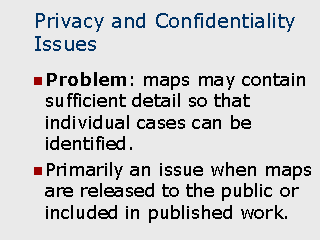| front |1 |2 |3 |4 |5 |6 |7 |8 |9 |10 |11 |12 |13 |14 |15 |16 |17 |18 |19 |20 |21 |22 |23 |24 |25 |review |
 |
Although maps are not the
same as tabular reports containing case level records, sufficient information may exist so
that individual cases can be identified. A real-world example: A map was created in which STD cases which were treated a county clinic were geocoded by address and shown as point locations which also contained street level detail. Although specific names and addresses were not provided on the map, the approximate addresses could easily be determined by located the STD points and identifying their locations on the appropriate streets In another example, if the map does not contain streets but does contain small regions such as block groups, the identify of an individual could be compromised on the basis of the gender or other characteristics of the individual and the region in which they reside. This is particularly an issue if there are only one or two individuals residing in a particular region. When working with confidential data, the epidemiologist or other researcher is entrusted to protect the personal information they use. Although, there are a variety of data protection methods to protect the privacy of the individuals’ records, maps pose a unique problem since they do not contain the detailed records but they contain a derivation of the information. If maps produced by a GIS are only used by the researcher(s) in the development of a study, the issue becomes one of simply protecting the confidential information from inappropriate physical access through use of passwords, encryption, restricted access to computers, etc. If, however, maps are to be made public, there is an additional layer of security which must be included to further protect the information. As noted by Richards, Croner, Rushton, Brown, and Folwer (1999), "Even if a single database may appear to have effective confidentiality safeguards, when several databases are linked within a geographic information system, the "sum" may be less well protected than the "parts." A false identification may be just as damaging to an individual as a correct identification that is not kept confidential." |